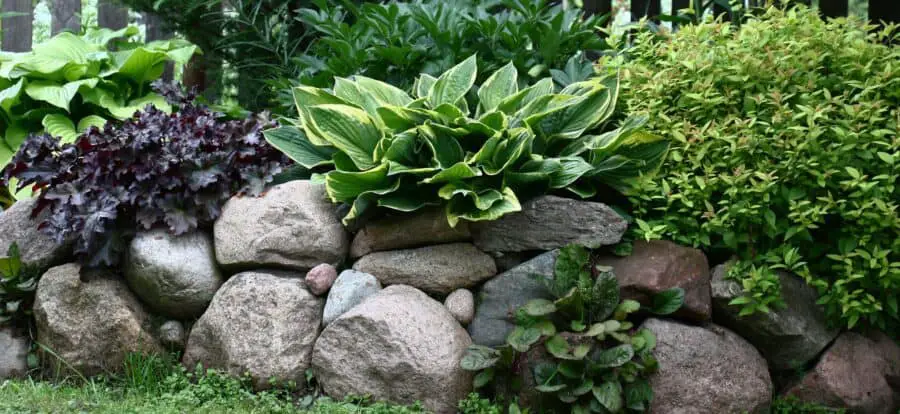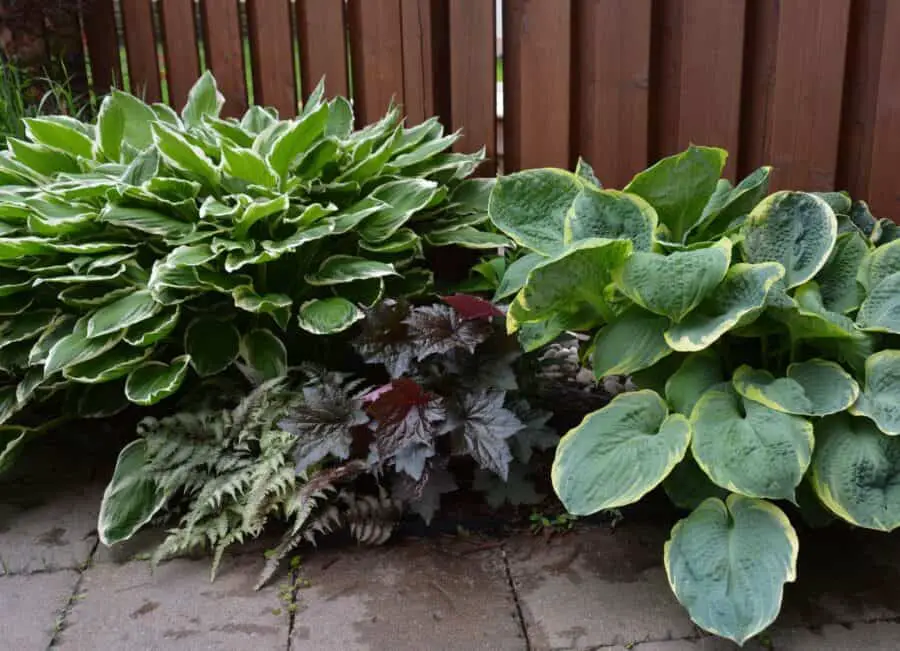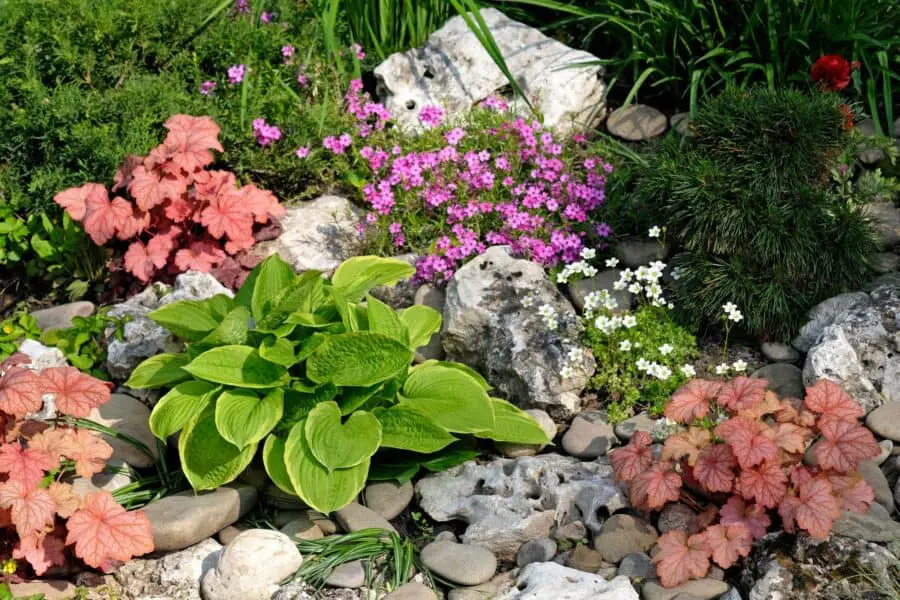These two perennials, coral bells, and hostas are both gorgeous plants. However, the mixing of the two multiplies their individual beauty when used together in coral bells and hosta gardens.
Both hostas and coral bells are excellent garden plants. I can say with confidence, having grown many thousands over the years in our nursery, that they are among the easiest perennials to grow.
Continue reading to find out more about these plants and how to combine them to create a stunning hosta and heuchera garden you can be proud of.
Why Grow a Coral Bells and Hosta Garden
Both are easy-to-care for perennials that prefer essentially the same growing conditions to flourish. Both are popular and widely available, with a diverse range of cultivars from both genera.
Hostas provide a strong anchor in the landscape and a graceful habit. Compared to heuchera, hostas can withstand more cold and heavier clay soil.
Early spring will see the emergence of coral bells, which will add color as we wait for the hostas to emerge later and show off their foliage. Coral Bells’ extensive spectrum of foliage hues provides color all throughout the season.
While both are shade plants coral bells tolerate the sun better than hostas.
Coral Bells Are More Than Heucheras
If you like dainty, check out coral bells related genus Tiarella with their starry little flowers. They scale nicely with miniature and small hostas.
There are also intergenic hybrids of Heuchera and Tiarella named Heucherella with the common name of Foamy Bells. There are some beautiful surprises in this genus like Heucherella Hot Buttered Rum and Sweet Tea, to name two that I like.
How to Make Your Own Hosta and Heuchera Garden
Garden design may be exciting and demanding at the same time. For me, designing anything is difficult. Try it; I find it simple to put these plants together in a pleasing design.
We can create gardens with either vibrant, attention-grabbing colors or calming muted tones. The flowers may come and go, but the beauty of these two foliage plants will endure from spring until fall.
When the foliage overlaps and mingles, the effect is appealing. It will produce a stunning garden by letting the hostas and heuchera coexist and thrive beside one another.
Designing goes hand in hand with selecting which varieties you want to grow.
If you buy plants in pots instead of bare root, spread them out in the garden area and arrange and rearrange them until it you are happy with the results.
If you want to change the design down the road, you can always move the plants around. Yes, the plants’ growth will be slower for a while, but they will recover and grow fine.
Here are two sources of good design information that may help you in planning your garden. A Garden Design article and a Fine Gardening article.

How Big Should the Garden Be
Both coral bells and hostas will scale to most any size garden.
Small areas look better with smaller plants that fit the scale of the garden. Sizeable areas benefit from large plants (mostly hostas) in the background and smaller plants of both varieties as we move to the front of the garden.
The garden does not have to be in the ground, it can also be a container garden, and both coral bells and hostas make excellent container plants. This way you can use them on your deck, patio, or porch.
More than Aesthetics Go into Garden Design
Most hostas thrive in zones 3–8, although some struggle in zone 9 and largely perish in zone 10. Heat and humidity in warm zones can be stressful to hostas.
However, it is the lack of a cold period called vernalization that kills hostas sometimes quickly or causes them to decline for a year or two before dying.
Coral bells are hardy from zones 4 to 9. Look for cold hardy cultivars in Zones 3. In zone 10, choose cultivars that can withstand heat and humidity.
Surprisingly, the Terra Nova Nurseries’ Northern Exposure series will grow in both zones 3 and 10.
Selecting the Right Location
There is no such thing as an ideal location, so just work with what you have. The two most crucial things for this type of garden are some shade and good garden soil or dirt that we can amend and make work.
How Much Sun Is Needed
Both Heucheras and Hostas grow best with some protection from the hot afternoon sun. Dappled sunlight from tall trees works very well.
Create your own shade. Shade structures can be designed to blend into the landscape.
Many hostas can grow in heavy shade, especially the dark green leaf varieties. In shade areas with high levels of sunlight, there are many yellow varieties that will thrive.
Coral Bells do best in moderate or bright shade. Try to avoid areas of dense shade. In areas of soft sunlight like the Pacific Northwest, most do well in full sun.
What Kind of Soil Do I Need
Both plants grow best in rich, moist, but well-drained soil. If you have clay soil or sandy soil, the more you do to improve them, the better your garden will grow.
What Are Their Water Needs – Are They Compatible
Both hostas and coral bells are happy with an inch of water per week. Either rain or watering can provide this.

Preparing the Garden Area
Layout the garden area and remove weeds and debris from the area.
Unless you are blessed with rich loam soil, now is the time to improve the soil. Rich, well-draining soils produce vibrant gardens.
Any type of soil will benefit from the addition of compost or other organic.
Loosen the soil if needed. It makes it easier for the roots to grow and spread.
Add a liberal amount of organic matter into the garden area while it is easy to apply before the plants are added. Work the additives into the soil.
Regular additions once or twice a year will keep good soils in top shape and continue to improve poor soil types.
Planting Your Hosta and Heuchera Garden
I, like many others, have found that by selecting healthy, well-grown plants many future problems and the replacing plants is avoided.
Place your plants at the proper depth, all the roots in the ground and the crown of the plant exposed and level with the soil surface.
When finished planting, apply a layer of mulch to conserve water and limit weed germination. Finally, but most importantly, water the garden softly and deeply.
Pests and Diseases of This Garden
Deer are the most damaging pests to hostas, followed by voles and rabbits. Slugs and snails are the creepy crawlies you’ll have to deal with on your hostas.
Deer and rabbits are not as fond of coral bells because of their astringent taste. However, hunger and curiosity can cause damage. Also, the deer can trample the heuchera while grazing on the hostas. Keep them at bay.
Black Vine weevils can damage or even kill heucheras but are mostly a problem in the Pacific Northwest. Aphids are unsightly and can do some damage, but are easy to control with soap and water sprays.
When growing hostas, you should be mindful of the Hosta-X virus. There is no treatment. The only option is to uproot and destroy the plants. The simplest approach to avoid this issue is to only plant healthy, thriving plants.

Maintaining a Healthy Coral Bells and Hosta Garden
Oh, those cursed weeds. Sometimes, especially when the garden is young, it seems like a never-ending problem.
Weeding keeps the garden looking good and eliminates the competition, allowing your plants to grow at their best.
As mentioned earlier, the regular use of mulches every year will prevent the germination of many weed seeds and make weed control much easier.
Fertilize as needed and if you didn’t test the soil when you started the garden, test it now as a soil test will keep you on the right path.
Slow-release fertilizers are the easiest to use, but I am sure you have your favorite way to nourish your plants. If you want to use slow-release fertilization, here is a simple method.
Coral bells in zones 3 and 4 will benefit from a layer of winter mulch
Good quality compost, especially if it contains a reasonable amount of well-rotted manure, can be a complete fertilizer.
As mentioned earlier, hostas and coral bells, like about an inch of water a week in the growing season. Rain and your watering in whatever combination nature sets is fine. The easiest way to provide water if Mother Nature doesn’t is with sprinklers.
Closing Thoughts
Coral bells are short-lived compared to hostas, needing to be divided or replaced every three to four years because the crowns get woody and do not fill in as they did in the early years.
Hostas can live for decades but dividing them can rejuvenate the clumps, especially with the smaller ground cover hostas.
The size of the garden is not important. I remember the little happenstance clusters of plants in the nursery that would capture my attention.
Producing beauty in the garden is very satisfying for the soul.

